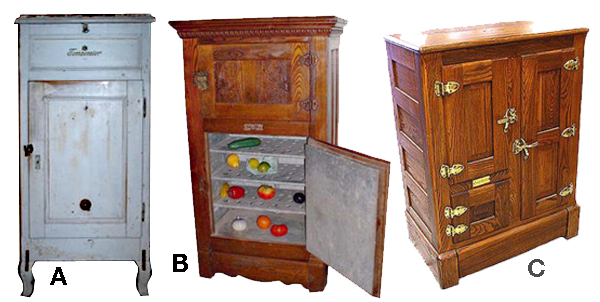
The Icebox (Non-Electric Refrigerator)
To keep food cold In the 1800s, wooden boxes lined with tin or zinc and insulated with various materials. These boxes were called “refrigerators” until the modern electric refrigerator was developed. Then they were referred to as “iceboxes.”
In 1915, the electric household refrigerator was introduced in the US, but it wasn’t until the 1920s that the market began to grow. This was due to a new refrigerant, Freon, which made them more reliable. By the 1930s, the average American family owned an electric refrigerator, but it wasn’t until the early 1950s that most American farms had electricity and could then buy one.
INFORMATION BELOW FROM 1800s COOKBOOKS:
THE REFRIGERATOR
For home use, the refrigerator offers the most convenient means of keeping foods in good condition. The construction and use of refrigerators are based on the well-known scientific fact that air expands and rises when it becomes warm. The same thing occurs in a refrigerator. As air comes in contact with the ice, it is cooled and falls, and the warm air is forced up. Thus the air is kept in constant motion, or circulation.
All refrigerators are constructed in a similar manner, having two or more layers of wood between which is placed an insulating material, such as cork, asbestos, or mineral wool. The food compartments are lined with tile, zinc, or other rust-proof material, and the ice compartment is usually lined with rust-proof metal, so as to be water-tight and unbreakable.
Any refrigerator may be made to serve the purpose of preserving food effectively if it is well constructed, the ice chamber kept as full of ice as possible, and the housewife knows how to arrange the foods in the food chambers to the best advantage.
Select a large refrigerator of simple construction and of hardwood, with the lining of zinc or marble and the shelves of slate or hardwood. A good refrigerator properly cared for should last at least twenty-five years.
CARE OF THE REFRIGERATOR
Attention must be given to the care of the refrigerator, for only when it is clean and dry can the growth of bacteria that attack foods be prevented.
Keeping the refrigerator clean and dry also insures wholesome food. To accomplish this, nothing should be allowed to spoil in it, and anything spilled in the refrigerator should be cleaned out immediately. The foods that are left over should be carefully inspected every day, and anything not likely to be used within a day or so should be disposed of.
At least once a week the food should be removed from all compartments. Shelves and all portable parts, when washed and scalded, should be placed in the sun to dry. If this is impossible, dry before a fire. The inside of the refrigerator should likewise be washed, rinsed, and wiped dry.Empty and clean the drip pan or pour boiling water down the waste pipe.
The ice chamber of the refrigerator should also be cleaned frequently. The best time to do this being when the ice has melted enough to be lifted out conveniently. To prevent the ice from melting rapidly when it is out of the refrigerator, it may be wrapped in paper or a piece of old blanket. But this covering must be removed when the ice is replaced in the chamber. Otherwise, it would be impossible to chill the refrigerator properly, the temperature remaining the same as that outside. It is as the ice gradually melts that the air in the refrigerator becomes cool.
Every effort should be made to keep the ice from wasting. Therefore, while the refrigerator should be kept in a convenient place, it should not be exposed to too great heat. And never keep the doors or covers of the refrigerator open unnecessarily long; it wastes the ice. Keep a good supply of ice in the ice chamber, as it is cheaper in the end.
CARE OF FOOD IN THE REFRIGERATOR
All dishes containing food should be wiped dry before they are placed in the refrigerator. As butter and milk are likely to become contaminated with odors given off by other foods, they should be properly protected. The milk bottles should always be closed and the butter carefully wrapped or put in a covered receptacle. Eggs should be kept in the small compartment.
Onions, cabbage, and other foods with strong odors, when placed in the refrigerator, should be kept in tightly closed jars or dishes, so that the odors will not escape. Before fresh fruits and perishable vegetables are put into the refrigerator, they should be carefully looked over and all decayed portions removed from them.
Cooked foods should never be placed in the refrigerator without first allowing them to cool. The steam given off when a dish of hot food comes in contact with the cold air makes the refrigerator damp and causes an undue waste of ice by warming the air. No food should be placed in the ice chamber, because this will cause the ice to melt unnecessarily.
=================================================
Do You Remember Having the Defrost Your Freezer Before Frost-Free Ones Were Introduced? What a Chore!
=================================================

2 thoughts on “The Icebox (Non-Electric Refrigerator)”
When my husband and his two sisters were quite young they climbed into one of these iceboxes and slammed the door shut. Luckily for them, and for me, their mother heard them and let them out.
I still have to defrost our chest freezer. Yep. It is a chore!
Yes, I’ve heard of children getting trapped in the older refrigerators. I used to defrost my small freezer of my refrigerator/freezer. I would boil water on the stove and put a hot pan of water in the freezer. Kind of a mess, but it worked.